Example Gallery
Showcase
class ECBvsCBCExample(Scene):
# Demonstrates how plaintext changes propagate in ECB and CBC modes.
def construct(self):
ecb = ECBBlocks(bytes(16*5), direction=RIGHT, zoom=0.36)
cbc = CBCBlocks(bytes(16*5))
cbc.zoom(ecb.width / cbc.width)
for e, c in zip(ecb, cbc):
e.align_to(c, DOWN)
self.add(
ecb.move_to(LEFT*(32/9)),
cbc.move_to(RIGHT*(32/9)).align_to(ecb, DOWN),
DashedLine(3*UP, 3*DOWN, color=C_STROKE),
)
ecb_block = ecb[2]
cbc_block = cbc[2]
self.play(LaggedStart(
FocusOn(ecb_block.pt[0].get_edge_center(LEFT)),
Rewrite(ecb_block, b'\xff'+bytes(15)),
lag_ratio=0.7
))
self.wait()
self.play(LaggedStart(
FocusOn(cbc_block.pt[0].get_edge_center(LEFT)),
Rewrite(cbc_block, b'\xff'+bytes(15)),
lag_ratio=0.7
))
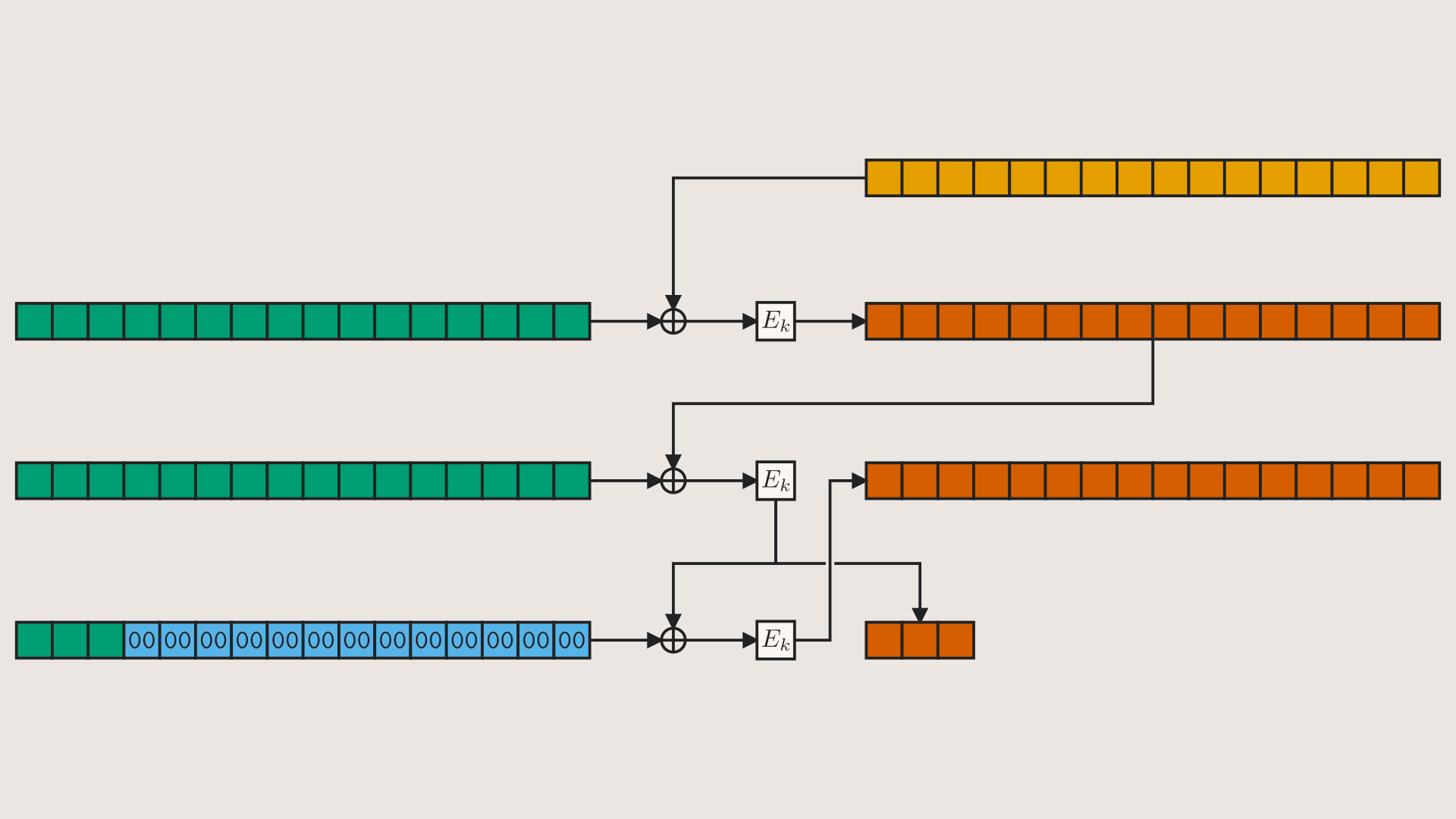
class CTSExample(Scene):
# Demonstrates modifying CBCBlock to create a figure for CTS mode
def construct(self):
block_0 = CBCBlock(direction=DOWN, margin=3)
block_1 = CBCBlock(prev=block_0, direction=DOWN, margin=3.4)
block_2 = CBCBlock(msg=[None]*3, prev=block_1, direction=DOWN, margin=3.4, padfunc=bytes)
block_1.remove(block_1.enc_to_ct)
block_2.remove(block_2.enc_to_ct)
block_2.remove(block_2.ct_to_xor)
block_2.ct.remove(*block_2.ct[3:])
stroke = DEFAULT_STROKE_WIDTH*0.66
enc_to_xor = BendyArrow(block_1.enc, DOWN, block_2.xor, UP, stroke_width=stroke)
enc_to_ct = BendyArrow(block_1.enc, DOWN, block_2.ct, UP, stroke_width=stroke, offset_ratio=0.524)
enc_to_ct_2 = BendyArrow(block_2.enc, RIGHT, block_1.ct, LEFT, stroke_width=stroke)
enc_to_ct_2_bg = Rectangle(width=0.12, height=0.3, stroke_opacity=0, fill_color=C_SCENE_BG, fill_opacity=1).move_to(enc_to_ct_2)
cts = ZoomableVGroup(
block_0, block_1, block_2,
enc_to_xor, enc_to_ct, enc_to_ct_2_bg, enc_to_ct_2,
).center().zoom(0.7)
self.add(cts)
class SlideExample1(Scene):
def construct(self):
token = list('email=foo@bar.com&uid=10&role=user')
last_len = len(token[32:])
pad_len = 16-last_len
block_1 = Block(token[:16], c_fills=C_PT)
block_2 = Block(token[16:32], c_fills=C_PT)
block_3 = PaddingBlock(token[32:])
ZoomableVGroup(block_1, block_2, block_3, zoom=0.8).arrange(DOWN).center()
self.add(block_1, block_2, block_3)
self.wait(0.5)
self.play(
LaggedStart(
FadeOut(block_3[2], scale=0.5, rate_func=rate_functions.ease_in_cubic),
FadeOut(block_3[3], scale=0.5, rate_func=rate_functions.ease_in_cubic),
Slide(*block_1, *block_2, *block_3, start=7, stop=-14, shift=2),
FadeIn(new_o_1 := block_1[7].copy(), scale=0.5),
FadeIn(new_o_2 := block_1[8].copy(), scale=0.5),
lag_ratio=0.25,
),
AnimationGroup(*[Rewrite(byte, 12, C_PAD) for byte in block_3[4:]]),
run_time=5,
)
self.wait()
new_block_1 = Block.from_boxes(*block_1[:7], new_o_1, new_o_2, *block_1[7:14])
new_block_2 = Block.from_boxes(*block_1[-2:], *block_2[:-2])
new_block_3 = Block.from_boxes(*block_2[-2:], *block_3[:2], *block_3[4:])
admin_block = Block(list("admin") + [11]*11, c_fills=C_PT, zoom=0.8)
self.play(
Group(
new_block_1,
admin_block,
new_block_2,
new_block_3,
).animate.arrange(DOWN).align_to(new_block_1, UP),
)
self.wait()
self.play(
admin_block.animate.move_to(new_block_2),
new_block_2.animate.move_to(admin_block),
)
self.wait(0.5)
self.play(
Rewrite(admin_block, c_fills=[C_PT]*5+[C_PAD]*11),
FadeOut(new_block_3),
)
self.wait()
class CodeRewriteExample1(Scene):
def construct(self):
kwargs = {"language": "python", "tab_width": 4, "font": "Monospace", "style": "inkpot", "background": "window", "line_spacing": 0.6, "insert_line_no": False}
code_1 = Code("code/padding_oracle_1.py", **kwargs).scale(0.5)
code_2 = Code("code/padding_oracle_2.py", **kwargs).scale(0.5).align_to(code_1, UL)
self.add(code_1)
self.wait(0.5)
self.play(CodeRewrite(code_1, code_2))
self.wait(0.5)
BendyArrow
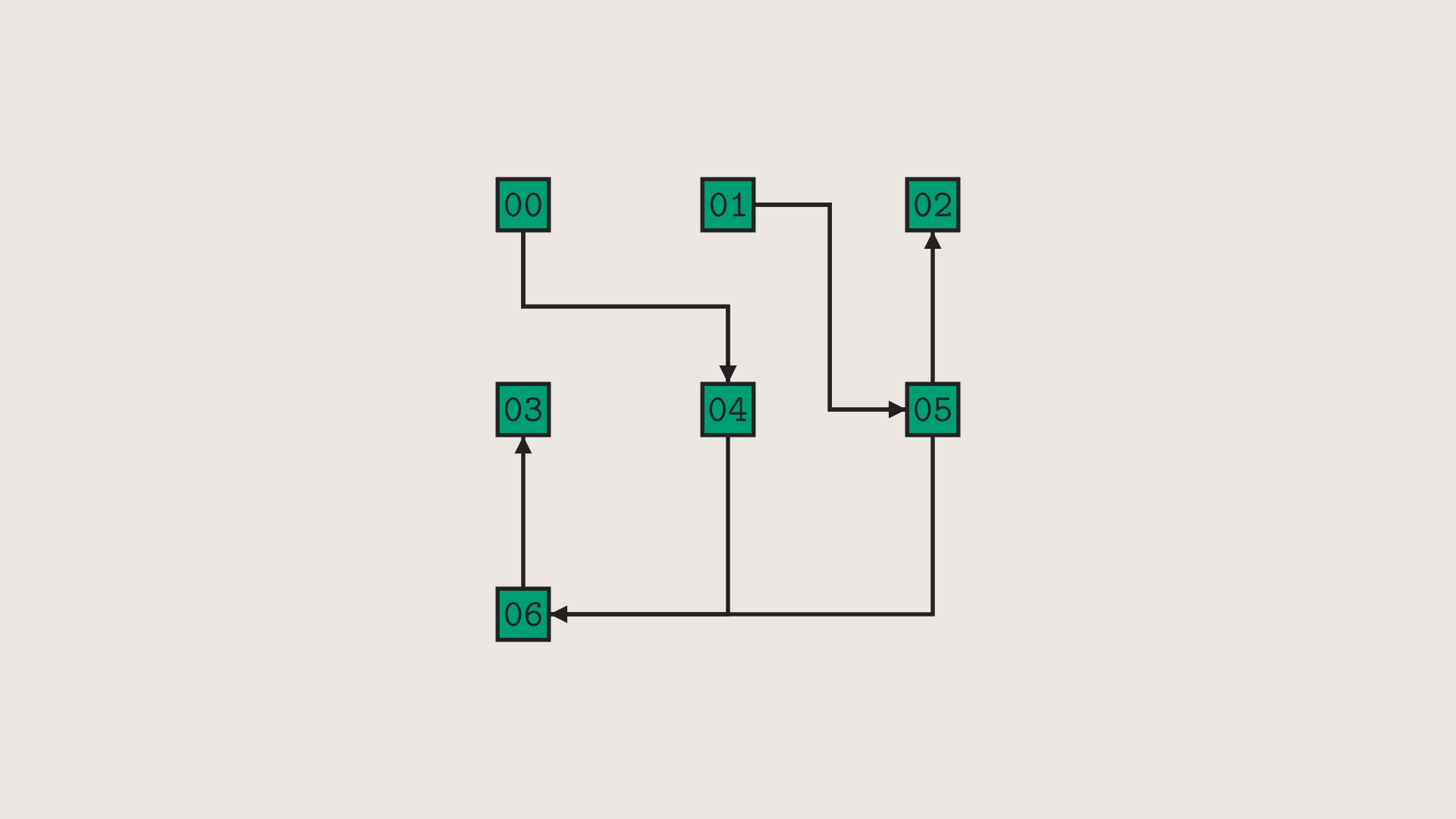
class BendyArrowExample1(Scene):
def construct(self):
boxes = VGroup(*[ByteBox(i, C_PT) for i in range(7)]).arrange_in_grid(buff=1.5)
self.add(boxes)
self.add(BendyArrow(boxes[0], DOWN, boxes[4], UP))
arrow = BendyArrow(boxes[1], RIGHT, boxes[5], LEFT)
self.add(arrow)
# these arrows' paths are arbitrary, but i think they look neat
# directional arguments indicate where to come out of (point into) the source (destination)
self.add(
BendyArrow(boxes[0], DOWN, boxes[4], UP),
BendyArrow(boxes[4], DOWN, boxes[6], RIGHT),
BendyArrow(boxes[5], DOWN, boxes[6], RIGHT),
BendyArrow(boxes[6], UP, boxes[3], DOWN),
BendyArrow(boxes[1], RIGHT, boxes[5], LEFT),
BendyArrow(boxes[5], UP, boxes[2], DOWN),
)
Block
class SlideExample1(Scene):
def construct(self):
token = list('email=foo@bar.com&uid=10&role=user')
last_len = len(token[32:])
pad_len = 16-last_len
block_1 = Block(token[:16], c_fills=C_PT)
block_2 = Block(token[16:32], c_fills=C_PT)
block_3 = PaddingBlock(token[32:])
ZoomableVGroup(block_1, block_2, block_3, zoom=0.8).arrange(DOWN).center()
self.add(block_1, block_2, block_3)
self.wait(0.5)
self.play(
LaggedStart(
FadeOut(block_3[2], scale=0.5, rate_func=rate_functions.ease_in_cubic),
FadeOut(block_3[3], scale=0.5, rate_func=rate_functions.ease_in_cubic),
Slide(*block_1, *block_2, *block_3, start=7, stop=-14, shift=2),
FadeIn(new_o_1 := block_1[7].copy(), scale=0.5),
FadeIn(new_o_2 := block_1[8].copy(), scale=0.5),
lag_ratio=0.25,
),
AnimationGroup(*[Rewrite(byte, 12, C_PAD) for byte in block_3[4:]]),
run_time=5,
)
self.wait()
new_block_1 = Block.from_boxes(*block_1[:7], new_o_1, new_o_2, *block_1[7:14])
new_block_2 = Block.from_boxes(*block_1[-2:], *block_2[:-2])
new_block_3 = Block.from_boxes(*block_2[-2:], *block_3[:2], *block_3[4:])
admin_block = Block(list("admin") + [11]*11, c_fills=C_PT, zoom=0.8)
self.play(
Group(
new_block_1,
admin_block,
new_block_2,
new_block_3,
).animate.arrange(DOWN).align_to(new_block_1, UP),
)
self.wait()
self.play(
admin_block.animate.move_to(new_block_2),
new_block_2.animate.move_to(admin_block),
)
self.wait(0.5)
self.play(
Rewrite(admin_block, c_fills=[C_PT]*5+[C_PAD]*11),
FadeOut(new_block_3),
)
self.wait()
class BlockExample1(Scene):
def construct(self):
block = Block(bytes(16), c_fills=C_PT)
self.add(block)
self.wait()
self.play(Rewrite(block, [0xFF]*16, [C_PT, C_CT]*8))
self.wait()

class BlockExample2(Scene):
def construct(self):
from itertools import product
group = VGroup()
for color, size in product((C_BOX_BG, GRAY), (8, 16, 24)):
group.add(Block(range(size), c_fills=color, block_size=None)) # type: ignore # TODO fix type sig
group.arrange_in_grid(cols=1, buff=0.55)
self.add(group)
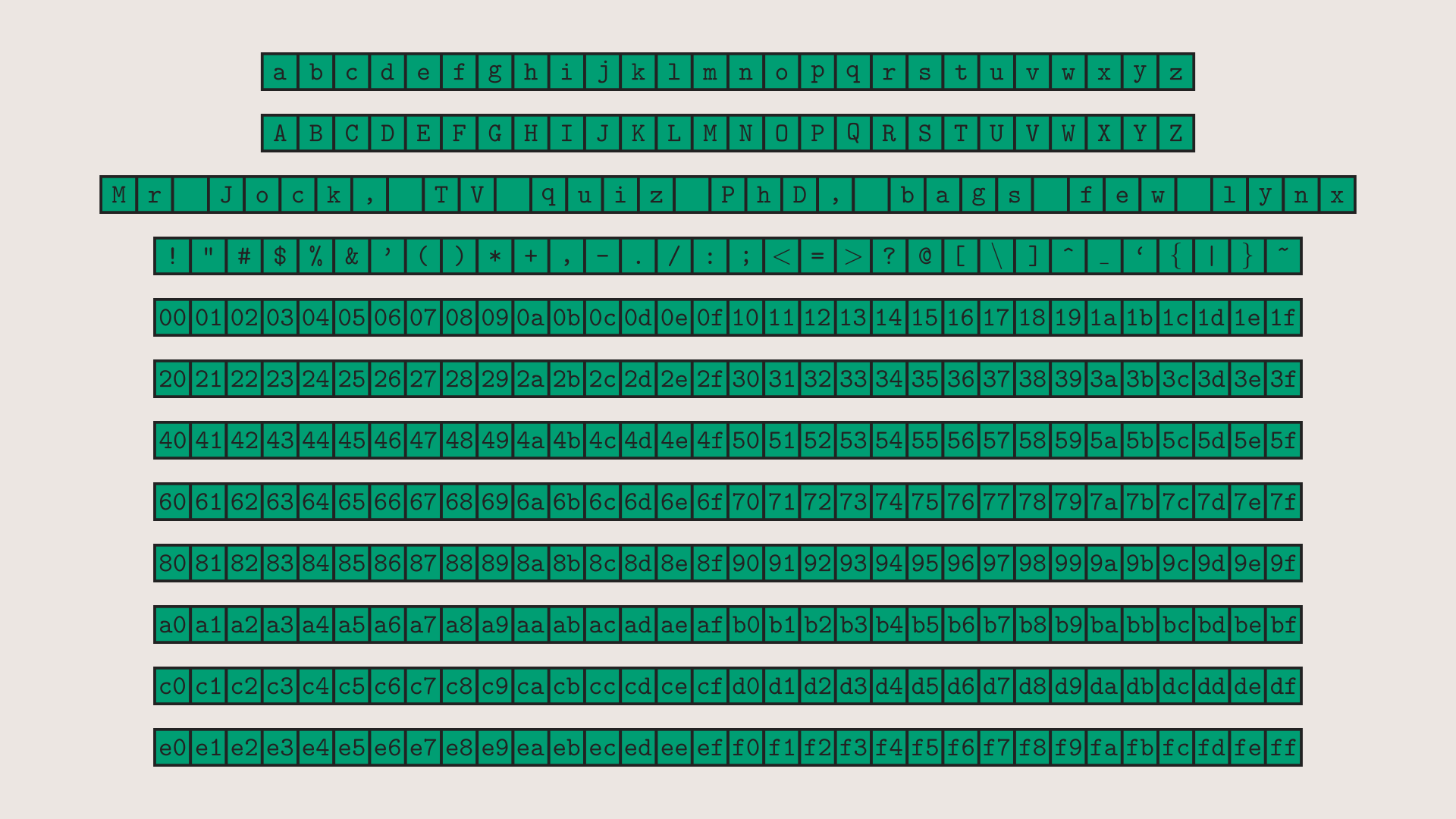
class BlockExample3(Scene):
# demonstrates cranim's custom handling of characters with tails (e.g. q, y).
# manim does not provide a built-in way of recognizing/handling descenders,
# and so centering them will take them off the baseline. That looks awful,
# so cranim's ByteBox automatically re-aligns them.
def construct(self):
from string import ascii_lowercase, ascii_uppercase, punctuation
block_style = {"c_fills": C_PT, "block_size": None, "zoom": 0.7}
blocks_style = {**block_style, "block_size": 32}
lower = Block(list(ascii_lowercase), **block_style)
upper = Block(list(ascii_uppercase), **block_style)
text = Block(list('Mr Jock, TV quiz PhD, bags few lynx'), **block_style)
punc = Block(list(punctuation), **block_style)
hexes = Blocks(range(256), **blocks_style)
blocks = Group(lower, upper, text, punc, *hexes)
blocks.arrange(DOWN).center()
self.add(blocks)
BoxLen
class BoxLenExample1(Scene):
def construct(self):
box = BoxLen("2^8")
self.add(box) # argument can be str, int, or anything else accepted by MathTex
print(self.mobjects)
self.play(box.update_rhs("256", transform=TextRewrite))
print(self.mobjects)
class BoxLenExample2(Scene):
def construct(self):
pad_blk = PaddingBlock()
msg_len = BoxLen(0)
pad_len = BoxLen(16, c_box=C_PAD)
self.add(
pad_blk,
msg_len.next_to(pad_blk, DOWN*2).align_to(pad_blk, LEFT),
pad_len.next_to(pad_blk, DOWN*2).align_to(pad_blk, RIGHT)
)
dec = lambda a, b: AnimationGroup(FadeOut(a, shift=0.2*UP), FadeIn(b, shift=0.2*UP))
inc = lambda a, b: AnimationGroup(FadeOut(a, shift=0.2*DOWN), FadeIn(b, shift=0.2*DOWN))
for i in range(1, 16):
self.play(
Rewrite(pad_blk, bytes(i)),
msg_len.update_rhs(i, transform=inc),
pad_len.update_rhs(16-i, transform=dec),
run_time=0.8
)
self.wait(0.2)
BufferToText
class BufferToTextExample1(Scene):
def construct(self):
pt_msg = "This is a plaintext string!"
text = Text(pt_msg).scale(0.7).shift(UP/3)
buff = Blocks(pt_msg, c_fills=C_PT, zoom=0.7, n_cols=2, buff=1/3).shift(DOWN/3)
self.add(buff)
self.wait(0.5)
self.play(BufferToText(buff, text, lag_ratio=0.05, unpad=True))
self.wait(0.5)
ByteBox
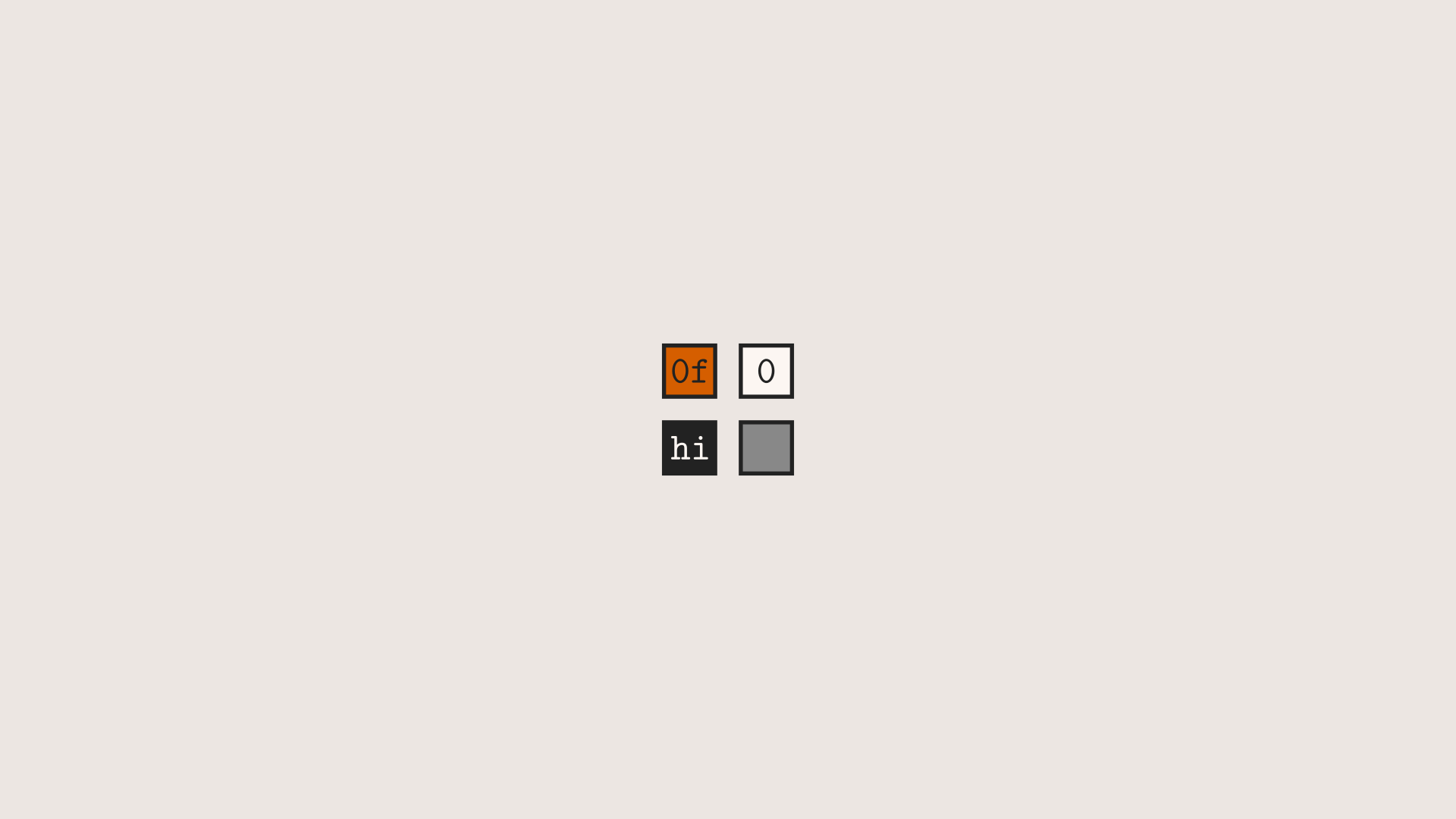
class ByteBoxExample1(Scene):
def construct(self):
# contents can be str, int, bytes, or None
box_1 = ByteBox(0xf, c_fill=C_CT) # numeric values are zero-padded as need be
box_2 = ByteBox('0') # length-1 strings are center-aligned
box_3 = ByteBox('hi', c_fill=C_STROKE, c_text=C_BOX_BG) # any string is allowed (but the box is sized to 2 chars)
box_4 = ByteBox(None, c_fill=GRAY) # to disable byte text, pass b=None
self.add(VGroup(box_1, box_2, box_3, box_4).arrange_in_grid())
class ByteBoxExample2(Scene):
def construct(self):
box = ByteBox('aa')
# demonstrate rewriting
self.play(FadeIn(box))
self.wait(0.5)
self.play(Rewrite(box, 'bb'))
# integer values are converted to hex and 0-padded
for i in (1, 0x23):
self.play(Rewrite(box, i))
self.wait(0.2)
# rewrite is compatible with zoom
self.play(box.animate.zoom(6)) # zoom() is like scale(), but it also adjusts stroke_width
self.wait(0.5) # so that border lines maintain their relative weight
self.play(Rewrite(box, '4'))
self.wait(0.5)
# zoom state persists through .copy()
box_2 = box.copy()
box_3 = box.copy().rewrite('7')
self.play(Group(box, box_2).animate.arrange(RIGHT, buff=1.2).center())
#self.wait(0.5)
# pass None to erase a box. it can still be re-populated at will
self.play(Rewrite(box, None), Rewrite(box_2, None))
self.play(LaggedStart(
Rewrite(box, '5', c_fill=C_PT),
Rewrite(box_2, '6', c_text=RED),
lag_ratio=0.33
))
self.play(
ReplacementTransform(VGroup(box.box, box_2.box), box_3.box),
ReplacementTransform(VGroup(box.text, box_2.text), box_3.text)
)
self.play(Rewrite(box_3, '8', c_fill=C_STROKE, c_text=C_BOX_BG))
self.play(Rewrite(box_3, '9'))
self.play(FadeOut(box_3, scale=1.2))
CBCBlock
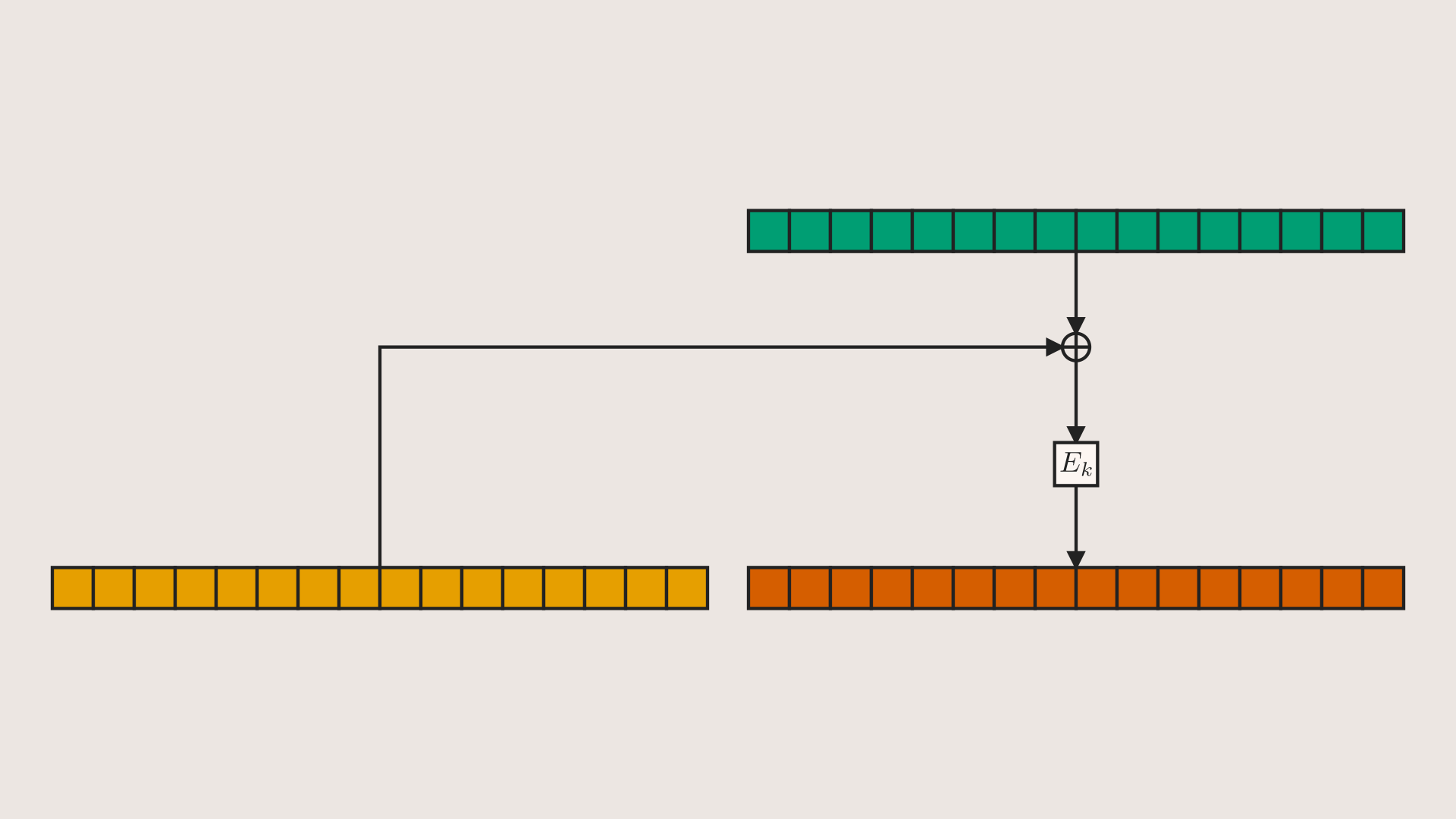
class CBCExample1(Scene):
def construct(self):
cbc = CBCBlock(zoom=0.8)
self.add(cbc)
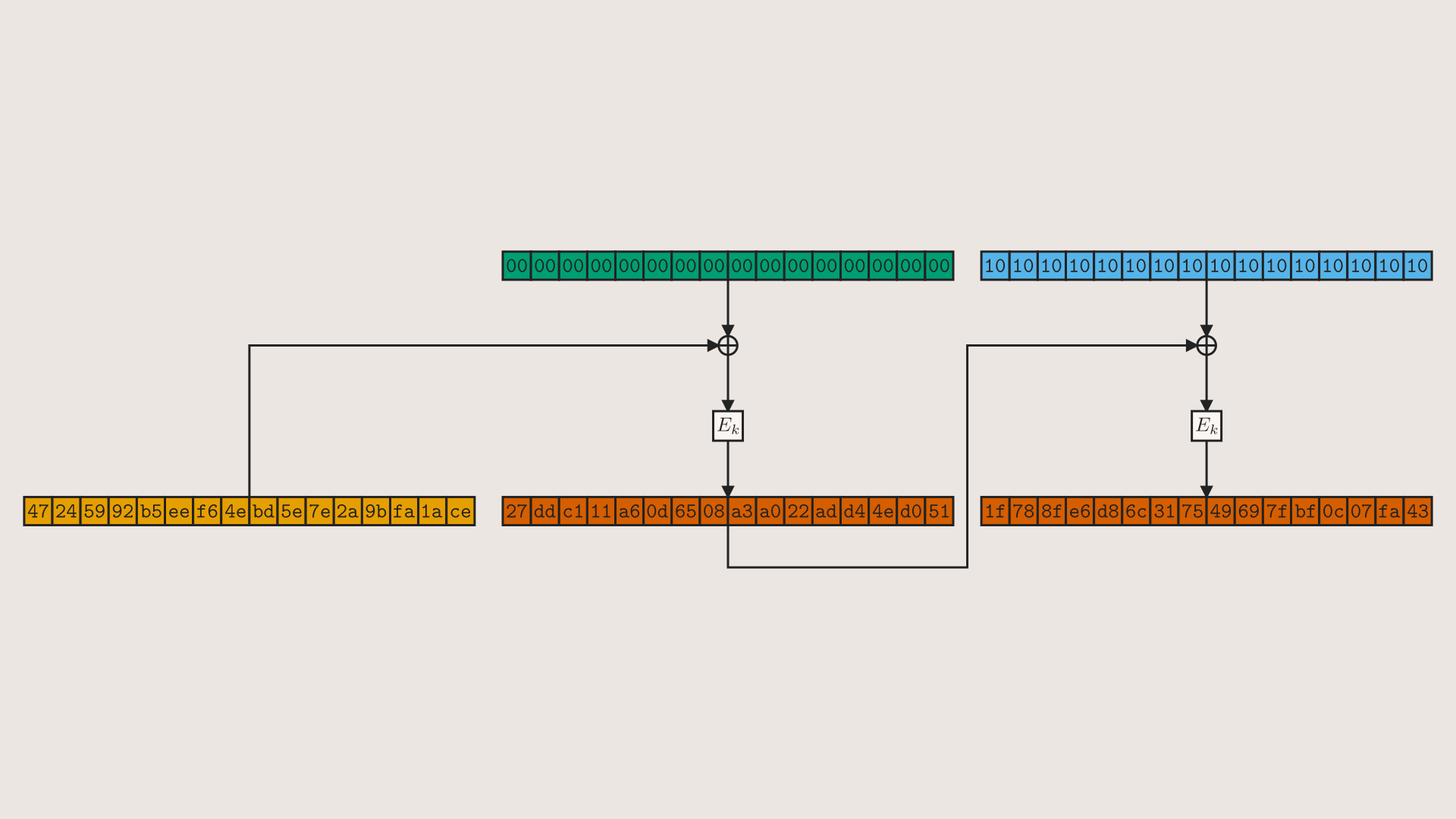
class CBCExample2(Scene):
def construct(self):
block_1 = CBCBlock(msg=bytes(16))
block_2 = CBCBlock(msg=bytes(), prev=block_1)
cbc_group = ZoomableVGroup(block_1, block_2, zoom=0.55)
self.add(cbc_group.center())
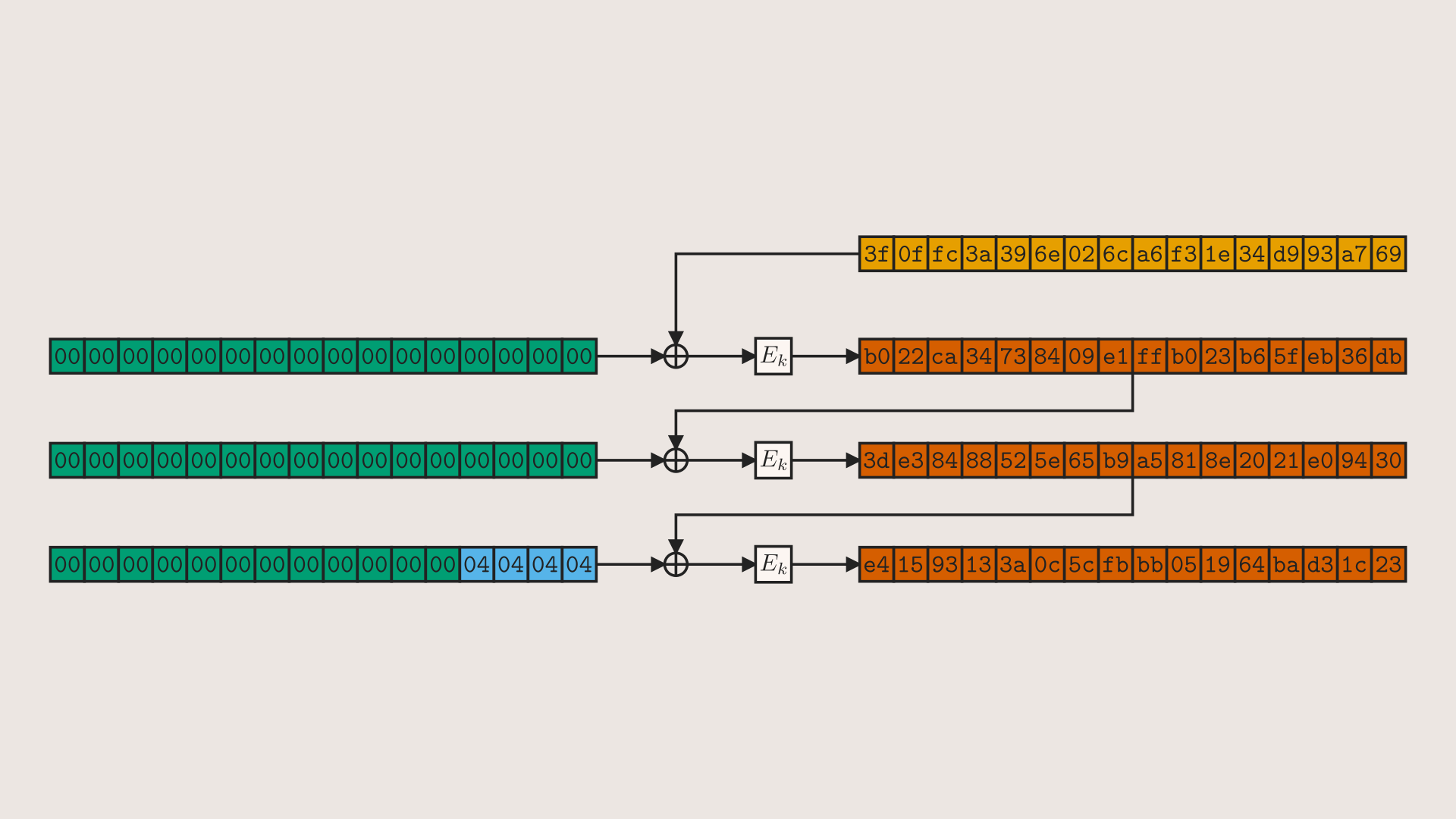
class CBCExample3(Scene):
def construct(self):
block_1 = CBCBlock(msg=bytes(16), direction=DOWN)
block_2 = CBCBlock(msg=bytes(16), prev=block_1, direction=DOWN)
block_3 = CBCBlock(msg=bytes(12), prev=block_2, direction=DOWN)
self.add(ZoomableVGroup(block_1, block_2, block_3, zoom=2/3).center())
class CBCExample4(MovingCameraScene): # Loops seamlessly
@staticmethod
def introduce(cbc):
# custom creation animation - Create(cbc) and Write(cbc) also work,
# but i think this looks nicer
return LaggedStart(
AnimationGroup(
Write(cbc.ct_to_xor),
Write(cbc.pt_to_xor),
Write(cbc.xor_to_enc),
Write(cbc.enc_to_ct),
FadeIn(cbc.xor),
FadeIn(cbc.enc),
),
FadeIn(cbc.ct, shift=0.5*DOWN, run_time=0.5),
lag_ratio=0.2
)
def construct(self):
iv_block = CBCBlock()
chained_1 = CBCBlock(prev=iv_block)
chained_2 = CBCBlock(prev=chained_1)
chained_3 = CBCBlock(prev=chained_2)
chained_4 = CBCBlock(prev=chained_3)
chained_5 = CBCBlock(prev=chained_4)
chained_6 = CBCBlock(prev=chained_5)
self.add(iv_block, chained_1, chained_2, chained_3, chained_4.pt, chained_5.pt, chained_6.pt)
self.camera.frame.scale(2.2).move_to(chained_2.xor_to_enc)
self.play(
self.introduce(chained_4),
self.camera.frame.animate(rate_func=linear).move_to(chained_3.xor_to_enc),
run_time=2
)
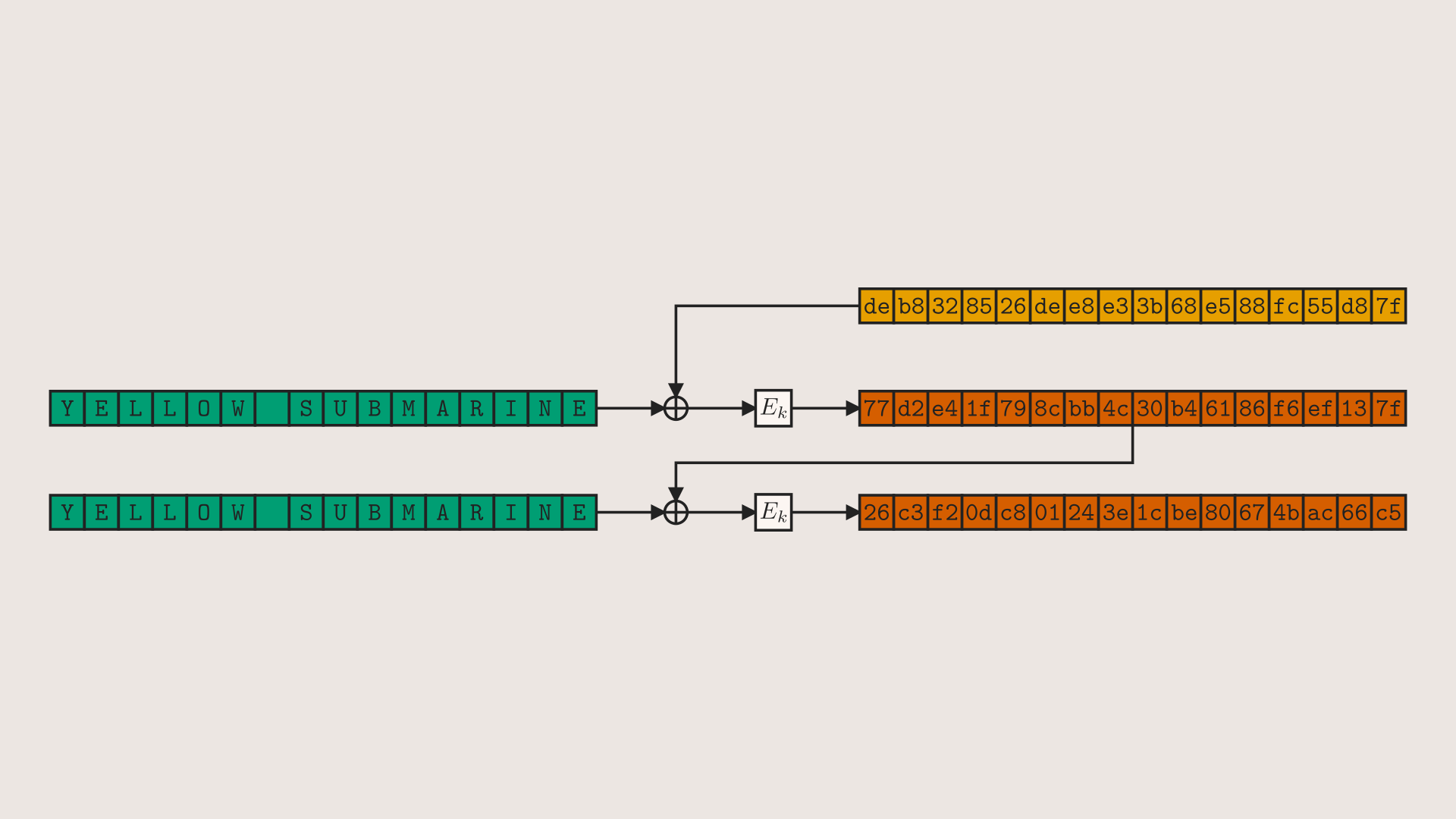
class CBCExample5(Scene):
def construct(self):
# accepts and automatically encodes strings (assumes ASCII)
blocks = CBCBlocks("YELLOW SUBMARINE"*2, zoom=2/3)
self.add(blocks)
class CBCExample6(Scene):
def construct(self):
blocks = CBCBlocks("YELLOW SUBMARINE"*3, zoom=2/3)
self.add(blocks)
self.wait(0.5)
self.play(Rewrite(blocks[0], "MISTER BOATSWAIN"))
self.wait(0.5)
CodeRewrite
class CodeRewriteExample1(Scene):
def construct(self):
kwargs = {"language": "python", "tab_width": 4, "font": "Monospace", "style": "inkpot", "background": "window", "line_spacing": 0.6, "insert_line_no": False}
code_1 = Code("code/padding_oracle_1.py", **kwargs).scale(0.5)
code_2 = Code("code/padding_oracle_2.py", **kwargs).scale(0.5).align_to(code_1, UL)
self.add(code_1)
self.wait(0.5)
self.play(CodeRewrite(code_1, code_2))
self.wait(0.5)
Cycle
class CycleExample1(Scene):
def construct(self):
box = ByteBox(0)
self.add(box)
self.wait(0.5)
self.play(Cycle(box, range(256)))
self.wait(0.5)
ECBBlock
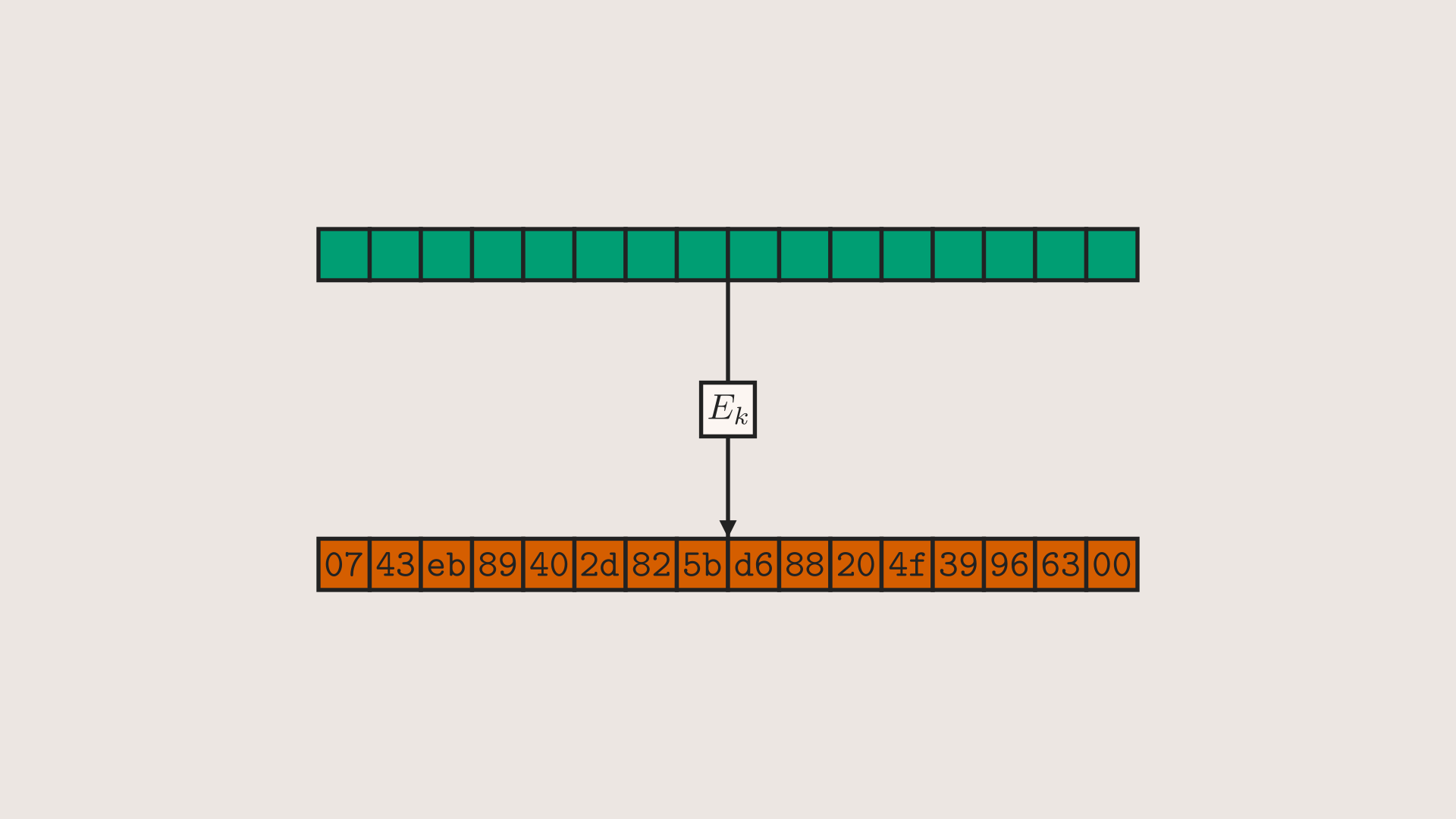
class ECBExample1(Scene):
def construct(self):
self.add(ECBBlock())
class ECBExample3(Scene):
def construct(self):
blocks = ECBBlocks(bytes(16*8), direction=RIGHT, pbuff=0.4)
self.add(blocks.zoom(0.7))
self.wait()
new_msg = bytes(15) + b'\x01'
new_pt_fills, new_ct_fills = [C_PT]*15 + [darken(C_PT, amount=0.25)], darken(C_CT, amount=0.25)
self.play(*[
Rewrite(row, new_msg, c_pt=new_pt_fills, c_ct=new_ct_fills)
for row in blocks[4:]
])
self.wait()
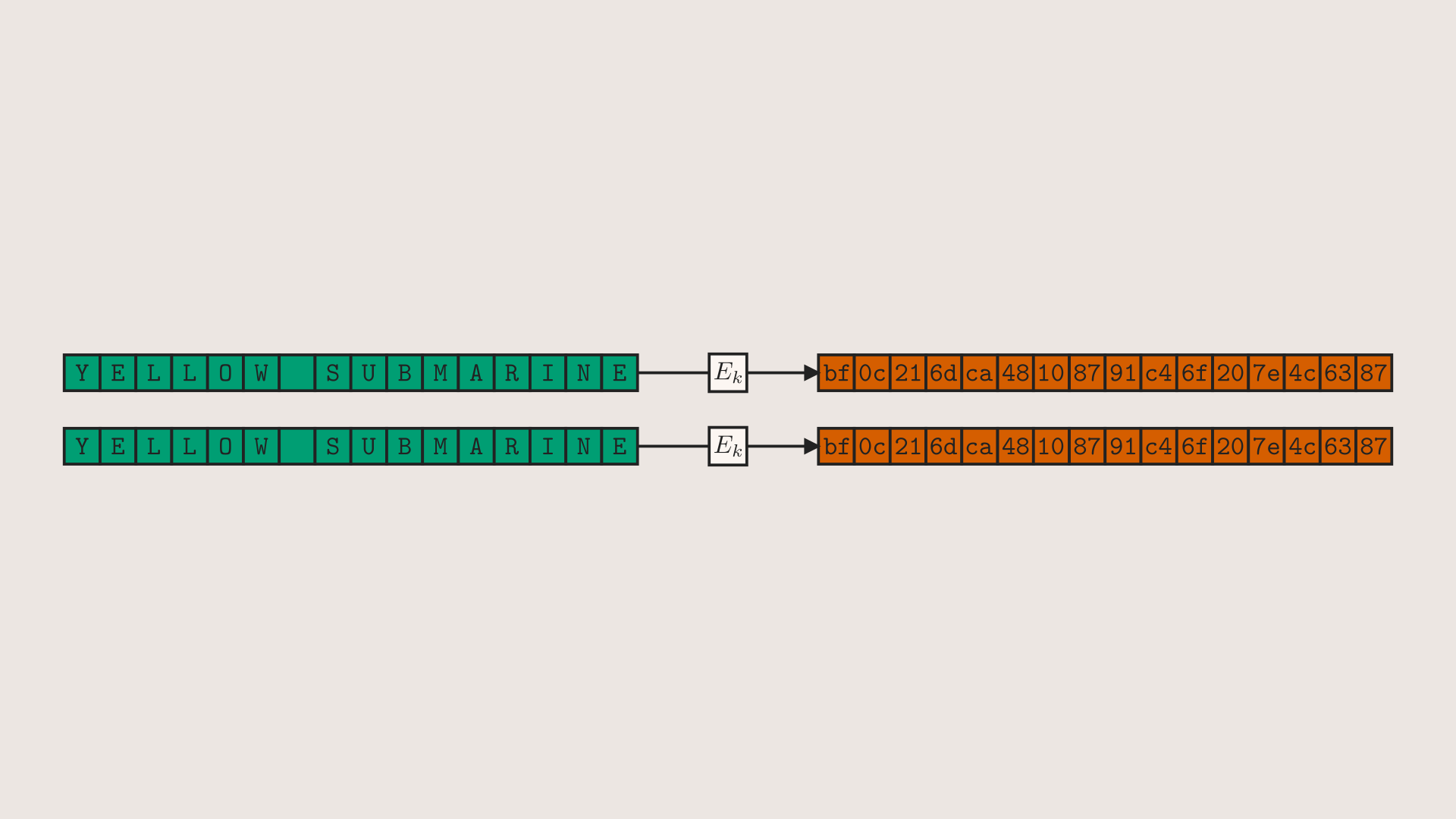
class ECBExample4(Scene):
def construct(self):
# you can use ASCII strings as inputs and they will be automatically encoded
blocks = ECBBlocks("YELLOW SUBMARINE"*2, direction=RIGHT)
self.add(blocks.zoom(0.7))
ECBBlocks
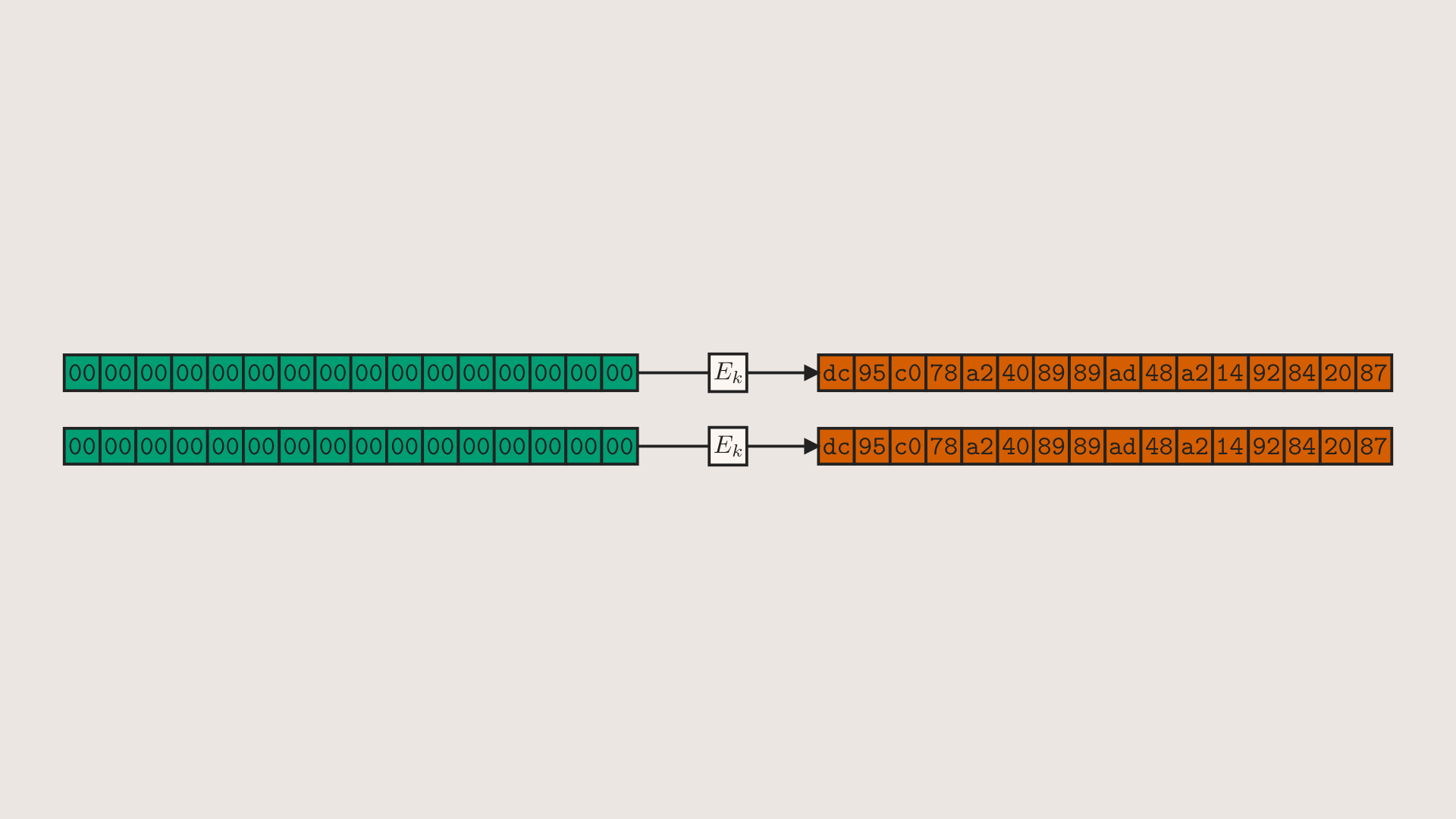
class ECBExample2(Scene):
def construct(self):
self.add(ECBBlocks(bytes(32), zoom=0.7))
FuncBox
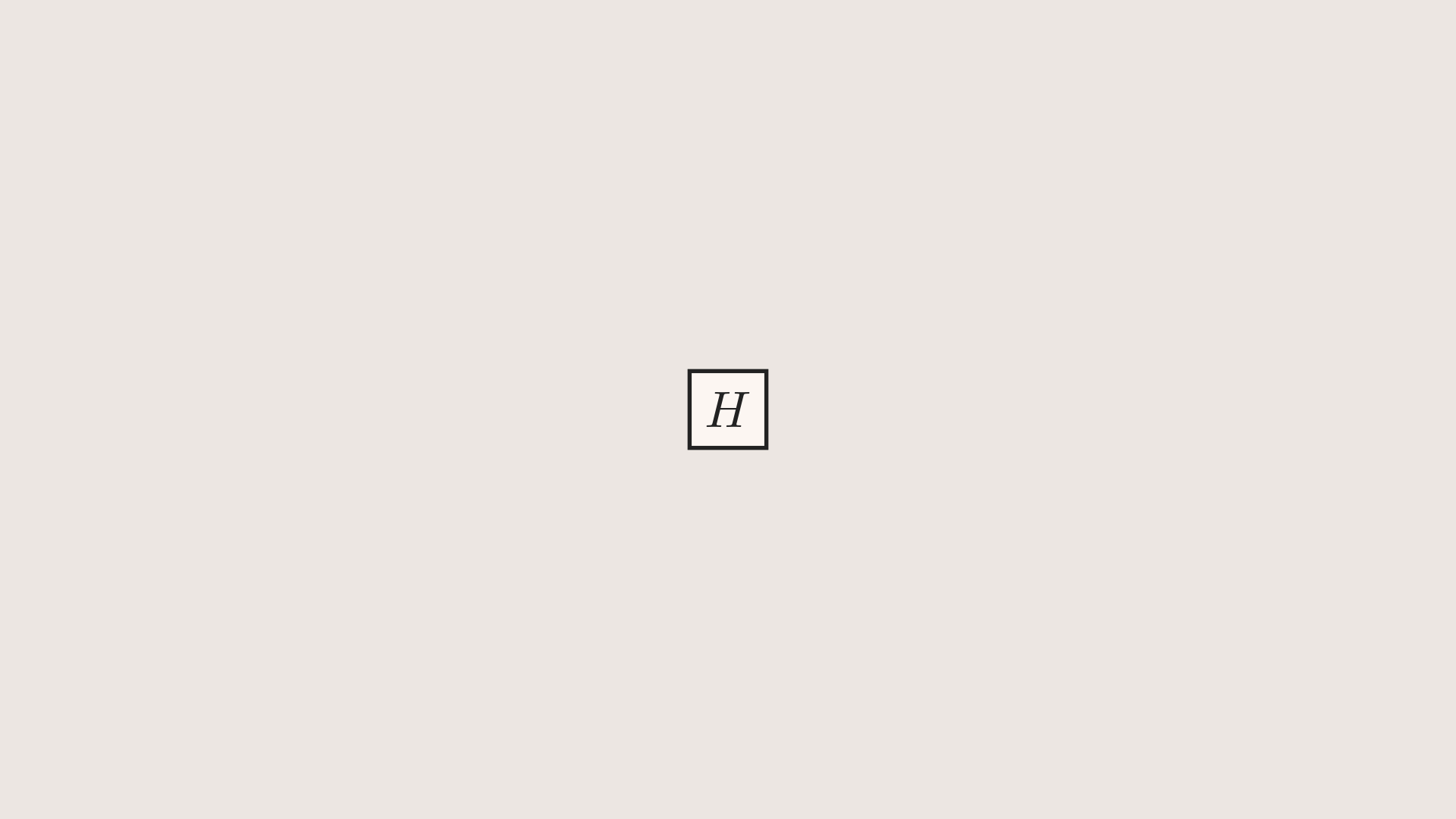
class FuncBoxExample1(Scene):
def construct(self):
self.add(FuncBox("H"))
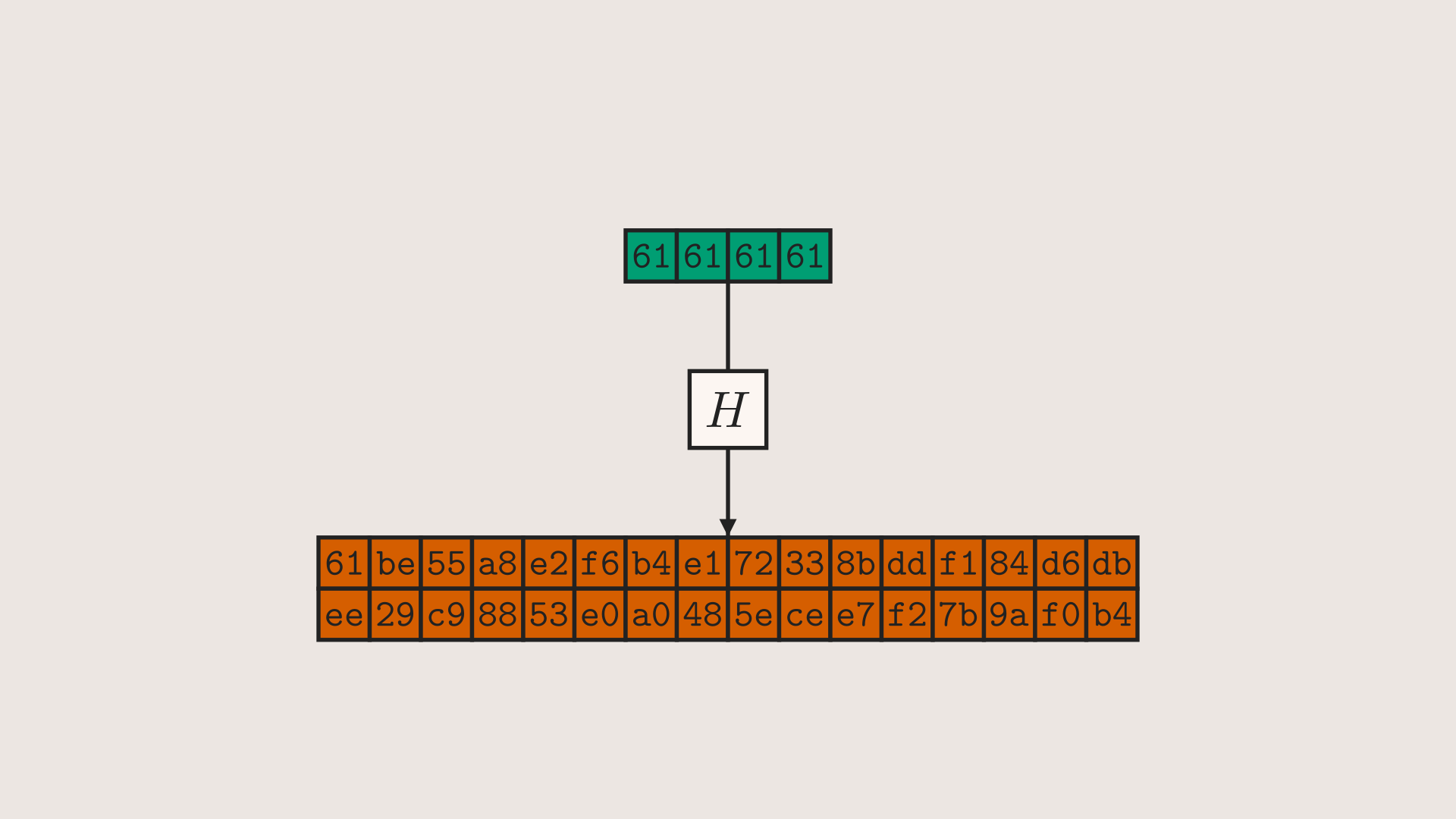
class FuncBoxExample2(Scene):
def construct(self):
from hashlib import sha256
msg = b'aaaa'
img = sha256(msg).digest()
input_block = Block(msg, c_fills=C_PT, block_size=None)
output_block_1 = Block(img[:16], c_fills=C_CT) # first half of digest
output_block_2 = Block(img[16:], c_fills=C_CT) # second half of digest
input_block.shift(UP*1.5)
output_block_1.shift(DOWN*1.5)
output_block_2.next_to(output_block_1, DOWN, buff=0.00)
func_box = FuncBox.with_arrows(
(input_block, DOWN, UP),
(output_block_1, DOWN, UP),
r"H",
)
self.add(input_block, output_block_1, output_block_2, func_box)
class FuncBoxExample3(Scene):
def construct(self):
from hashlib import sha256
msg = b'aaaa'
hsh = sha256(msg).digest()
input_block = Block(msg, c_fills=C_PT, block_size=None)
output_block_1 = Block(hsh[:16], c_fills=C_CT) # first half of digest
output_block_2 = Block(hsh[16:], c_fills=C_CT) # second half of digest
input_block.shift(UP*1.5)
output_block_1.shift(DOWN*1.5)
output_block_2.next_to(output_block_1, DOWN, buff=0.00)
func_box = FuncBox.with_arrows(
(input_block, DOWN, UP),
(output_block_1, DOWN, UP),
"H",
)
self.play(FadeIn(input_block), run_time=1)
self.play(Write(func_box))
self.play(FadeIn(output_block_1, output_block_2, shift=DOWN*0.5), run_time=0.8)
self.wait()
PaddingBlock
class PaddingBlockExample1(Scene):
def construct(self):
#global pb
pb = PaddingBlock(bytes(15))
self.add(pb)
self.wait(0.5)
for i in (14, 13, 12):
self.play(Rewrite(pb, bytes(i)))
self.wait(0.25)
for i in range(11, 0, -1):
pb.rewrite(bytes(i))
self.wait(0.25)
pb.rewrite(bytes(0))
self.wait()
self.play(FadeOut(pb))
class PaddingBlockExample2(Scene):
def construct(self):
pb = PaddingBlock(bytes(6))
self.add(pb)
self.wait(1)
self.play(Rewrite(pb, bytes(6), padfunc=lambda l: b'\x00'*l))
self.wait(0.17)
self.play(Wiggle(pb[5:7], n_wiggles=17, run_time=4))
self.play(Rewrite(pb, bytes(6), padfunc=lambda l: b'\x80' + b'\x00'*(l-1)))
self.wait(1)
class PaddingBlockExample3(Scene):
def construct(self):
self.add(Point(), Point(), Point(), Point())
block = PaddingBlock(
[None]*3, # ensure message bytes are blank
c_pad=C_BOX_BG,
padfunc=lambda l: [None]*l # set padding bytes to None
)
# get local references (this is ugly - how could we clean it up?)
braces = block.get_braces(pad_text="?")
msg_brace, pad_brace, blk_brace = braces.msg_brace, braces.pad_brace, braces.blk_brace
msg_text, pad_text, blk_text = braces.msg_text, braces.pad_text, braces.blk_text
# introduce message bytes
self.play(
FadeIn(block.boxes[:3]),
FadeIn(msg_brace, msg_text, shift=DOWN)
)
self.wait(0.5)
# introduce block
self.play(
FadeIn(block.boxes[3:]),
FadeIn(blk_brace, blk_text, shift=UP),
)
self.play(
FadeIn(pad_brace, pad_text, shift=DOWN) # but wait - what's this?
)
self.wait(0.5)
# reveal: padding!
block.c_pad=PURPLE
self.play(
Rewrite(block, [None]*3),
#pad_text.animate.become(pad_brace.get_text("Padding").set_color(C_EDGE))
Transform(braces, block.get_braces())
)
# try changing the message size and moving the braces accordingly
for size in (5, 15, 8):
self.wait(0.5)
self.play(
Rewrite(block, [None]*size),
Transform(braces, block.get_braces())
)
self.wait(0.5)
self.play(FadeOut(block, braces))
self.wait(0.5)
class BoxLenExample2(Scene):
def construct(self):
pad_blk = PaddingBlock()
msg_len = BoxLen(0)
pad_len = BoxLen(16, c_box=C_PAD)
self.add(
pad_blk,
msg_len.next_to(pad_blk, DOWN*2).align_to(pad_blk, LEFT),
pad_len.next_to(pad_blk, DOWN*2).align_to(pad_blk, RIGHT)
)
dec = lambda a, b: AnimationGroup(FadeOut(a, shift=0.2*UP), FadeIn(b, shift=0.2*UP))
inc = lambda a, b: AnimationGroup(FadeOut(a, shift=0.2*DOWN), FadeIn(b, shift=0.2*DOWN))
for i in range(1, 16):
self.play(
Rewrite(pad_blk, bytes(i)),
msg_len.update_rhs(i, transform=inc),
pad_len.update_rhs(16-i, transform=dec),
run_time=0.8
)
self.wait(0.2)
Slide
class SlideExample1(Scene):
def construct(self):
token = list('email=foo@bar.com&uid=10&role=user')
last_len = len(token[32:])
pad_len = 16-last_len
block_1 = Block(token[:16], c_fills=C_PT)
block_2 = Block(token[16:32], c_fills=C_PT)
block_3 = PaddingBlock(token[32:])
ZoomableVGroup(block_1, block_2, block_3, zoom=0.8).arrange(DOWN).center()
self.add(block_1, block_2, block_3)
self.wait(0.5)
self.play(
LaggedStart(
FadeOut(block_3[2], scale=0.5, rate_func=rate_functions.ease_in_cubic),
FadeOut(block_3[3], scale=0.5, rate_func=rate_functions.ease_in_cubic),
Slide(*block_1, *block_2, *block_3, start=7, stop=-14, shift=2),
FadeIn(new_o_1 := block_1[7].copy(), scale=0.5),
FadeIn(new_o_2 := block_1[8].copy(), scale=0.5),
lag_ratio=0.25,
),
AnimationGroup(*[Rewrite(byte, 12, C_PAD) for byte in block_3[4:]]),
run_time=5,
)
self.wait()
new_block_1 = Block.from_boxes(*block_1[:7], new_o_1, new_o_2, *block_1[7:14])
new_block_2 = Block.from_boxes(*block_1[-2:], *block_2[:-2])
new_block_3 = Block.from_boxes(*block_2[-2:], *block_3[:2], *block_3[4:])
admin_block = Block(list("admin") + [11]*11, c_fills=C_PT, zoom=0.8)
self.play(
Group(
new_block_1,
admin_block,
new_block_2,
new_block_3,
).animate.arrange(DOWN).align_to(new_block_1, UP),
)
self.wait()
self.play(
admin_block.animate.move_to(new_block_2),
new_block_2.animate.move_to(admin_block),
)
self.wait(0.5)
self.play(
Rewrite(admin_block, c_fills=[C_PT]*5+[C_PAD]*11),
FadeOut(new_block_3),
)
self.wait()
TextToBuffer
class TextToBufferExample1(Scene):
def construct(self):
pt_msg = "This is a plaintext string!"
text = Text(pt_msg).scale(0.7).shift(UP/3)
buff = Blocks(pt_msg, c_fills=C_PT, zoom=0.7, n_cols=2, buff=1/3).shift(DOWN/3)
self.add(text)
self.wait(0.5)
self.play(TextToBuffer(text, buff, lag_ratio=0.05))
self.wait(0.5)